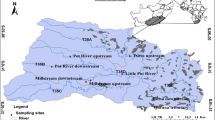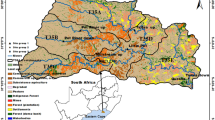Abstract
Sedimentation arising from agricultural run-offs, riparian habitat fragmentation and channel bank erosion has long been known to impair the structure and ecological functioning of stream and river ecosystems. This study examined the effects of fine sediment grain sizes on the functional feeding group structure of Ephemeroptera, Plecoptera and Trichoptera (EPT) in the Tsitsa River catchment in the Eastern Cape Province of South Africa. Fine sediments and EPT were sampled between August 2016 and April 2017 from eight selected sampling sites. The eight sites were classified into four groups in terms of fine sediments and turbidity to represent a gradient of sediment stress, with site groups 4 and 3 being less influenced and groups 2 and 1 as the highly influenced groups. EPT genera/species were assigned to five functional feeding groups (FFGs) and their responses to sediment stress assessed. The results of the study showed that of the five FFGs, four (i.e. collector-filterer, collector-gatherer, scraper/grazer and shredder) were significantly different between the four groups, separating the impacted groups from the less impacted groups. Redundancy analysis (RDA) showed that FFGs such as scraper/grazer, collector-gatherer and shredder were tolerant to fine sediment, especially during the dry season. Collector-filterers and predators were the most sensitive FFGs observed in the studied river systems. The RDA results showed that the coarser grain size fractions (very coarse and coarse silt, very fine sand and turbidity) displayed more severe negative effects on EPT FFGs when compared with the finer grain size fractions such as very fine and fine silt. The results obtained in this study provided more insights into the response patterns and functional dynamics of EPTs in the Tsitsa River systems, a knowledge that can contribute to trait-based biomonitoring in South Africa.




Similar content being viewed by others
References
Akamagwuna, F. C., Mensah, P. K., Nnadozie, C. F., & Odume, O. N. (2019). Trait-based responses of Ephemeroptera, Plecoptera, and Trichoptera to sediment stress in the Tsitsa River and its tributaries, Eastern Cape, South Africa. River Research and Applications, 35(April), 1–14. https://doi.org/10.1002/rra.3458.
American Public Health Association (APHA). American Water Works Association and Water Pollution Control Federation (1971). Standard methods for the examination of water and wastewater (13th ed.). USA: APHA Washington DC. Bäse.
Atkinson, B. L., Grace, M. R., Hart, B. T., & Vanderkruk, K. E. N. (2008). Sediment instability affects the rate and location of primary production and respiration in a sand-bed stream. Journal of the North American Benthological Society, 27(3), 581–592. https://doi.org/10.1899/07-143.1.
Bilotta, G. S., & Brazier, R. E. (2008). Understanding the influence of suspended solids on water quality and aquatic biota. Water Research, 42(12), 2849–2861. https://doi.org/10.1016/j.watres.2008.03.018.
Blott, S. J., & Pye, K. (2012). Particle size scales and classification of sediment types based on particle size distributions: Review and recommended procedures. Sedimentology, 59(7), 2071–2096. https://doi.org/10.1111/j.1365-3091.2012.01335.x.
Broekhuizen, N., Parkyn, S., & Miller, D. (2001). Fine sediment effects on feeding and growth in the invertebrate grazers. Hydrobiologia, 457, 125–132.
Bryce, S. A., Lomnicky, G. A., & Kaufmann, P. R. (2010). Protecting sediment-sensitive aquatic species in mountain streams through the application of biologically based streambed sediment criteria. Journal of the North American Benthological Society, 29(2), 657–672. https://doi.org/10.1899/09-061.1.
Conroy, E., Turner, J. N., Rymszewicz, A., Bruen, M., Sullivan, J. J. O., & Kelly-quinn, M. (2016). An evaluation of visual and measurement-based methods for estimating deposited fine sediment. International Journal of Sediment Research, 31(4), 368–375. https://doi.org/10.1016/j.ijsrc.2016.04.002.
Conroy, E., Turner, J. N., Rymszewicz, A., Bruen, M., O’Sullivan, J. J., Lawler, D. M., Stafford, S., & Kelly-Quinn, M. (2018). Further insights into the responses of macroinvertebrate species to burial by sediment. Hydrobiologia, 805, 399–411. https://doi.org/10.1007/s10750-017-3328-7.
Couceiro, S. R. M., Hamada, N., Forsberg, B. R., & Padovesi-Fonseca, C. (2011). Trophic structure of macroinvertebrates in Amazonian streams impacted by anthropogenic siltation an ec_2198 628..637. https://doi.org/10.1111/j.1442-9993.2010.02198.x.
De Moor, I. J., Day, J. A., & de Moor, F. (2003). Guides to the freshwater invertebrates of southern Africa: Insecta: Ephemeroptera, Odonata and Plecoptera. Water Research Commission, 7(report no.TT 207/03.).
Dickens, C. W., & Graham, P. M. (2002). The South African Scoring System (SASS) version 5 rapid bioassessment method for rivers. African Journal of Aquatic Science, 27(1), 1–10. https://doi.org/10.2989/16085914.2002.9626569.
Donohue, I., & Irvine, K. (2003). Effects of sediment particle size composition on survivorship of benthic invertebrates from Lake Tanganyika, Africa. Archiv für Hydrobiologie, 157(1), 131–144. https://doi.org/10.1127/0003-9136/2003/0157-0131.
Doretto, A., Piano, E., Bona, F., & Fenoglio, S. (2018). How to assess the impact of fine sediments on the macroinvertebrate communities of alpine streams? A selection of the best metrics. Ecological Indicators, 84, 60–69. https://doi.org/10.1016/j.ecolind.2017.08.041.
Encalada, A. C., CAlles, J., Ferreira, V., Canhoto, C. M., & Graça, M. A. S. (2010). Riparian land use and the relationship between the benthos and litter decomposition in tropical montane streams. Freshwater Biology, 55(8), 1719–1733. https://doi.org/10.1111/j.1365-2427.2010.02406.x.
Folk, R. L., & Ward, W. X. C. (1957). BRAZOS RIVER BAR: A STUDY IN THE SIGNIFICANCE OF GRAIN SIZE PARAMETERS (Vol. 27). Retrieved from https://www.semanticscholar.org/paper/Effects-of-deposited-sediments-on-temperate-stream-Larsen/0dc12fb1b69e779c4fb4959c5a1b0f772b08b9bc. Accessed 1 Aug 2017.
Gieswein, A., Hering, D., & Lorenz, A. W. (2019). Science of the total environment development and validation of a macroinvertebrate-based biomonitoring tool to assess fi ne sediment impact in small mountain streams. Science of the Total Environment, 652, 1290–1301. https://doi.org/10.1016/j.scitotenv.2018.10.180.
Gordon, A. K., Niedballa, J., & Palmer, G. C. (2013). Sediment as a physical water quality stressor on macro-invertebrates : A contribution to the development of a water quality guideline for suspended solids. WRC report no. 2040/1/13.
Hardie, S. A., & Bobbi, C. J. (2018). Compounding effects of agricultural land use and water use in free-flowing rivers: Confounding issues for environmental flows. Environmental Management, 61, 421–431. https://doi.org/10.1007/s00267-017-0836-1.
Jones, J. I., Murphy, J. F., Collins, A. L., Sear, D. A., Naden, P. S., & Armitage, P. D. (2012). The impact of fine sediment on macro-invertebrates. River Research and Applications, 28(8), 1055–1071. https://doi.org/10.1002/rra.1516.
Jonsson, M., Polvi, L. E., Sponseller, R. A., & Stenroth, K. (2018). Catchment properties predict autochthony in stream filter feeders. Hydrobiologia, 815(1), 83–95. https://doi.org/10.1007/s10750-018-3553-8.
Jun, Y.-C., Kim, N.-Y., Kwon, S.-J., Han, S.-C., Hwang, I.-C., Park, J.-H., … Hwang, S.-J. (2011). Effects of land use on benthic macroinvertebrate communities: Comparison of two mountain streams in Korea. https://doi.org/10.1051/limn/2011018.
Kaller, M. D., & Hartman, K. J. (2004). Evidence of a threshold level of fine sediment accumulation for altering benthic macroinvertebrate communities. 95–104.
Kemp, P., Sear, D., Collins, A., Naden, P., & Jones, I. (2011). The impacts of fine sediment on riverine fish. Hydrological Processes, 25(11), 1800–1821. https://doi.org/10.1002/hyp.7940.
Larsen, S., Pace, G., & Ormerod, S. J. (2011). Experimental effects of sediment deposition on the structure and function of macroinvertebrate assemblages in temperate streams. River Research and Applications, 27(2), 257–267. https://doi.org/10.1002/rra.1361.
Leitner, P., Hauer, C., Ofenböck, T., Pletterbauer, F., Schmidt-Kloiber, A., & Graf, W. (2015). Fine sediment deposition affects biodiversity and density of benthic macroinvertebrates: A case study in the freshwater pearl mussel river Waldaist (Upper Austria). Limnologica - Ecology and Management of Inland Waters, 50, 54–57. https://doi.org/10.1016/j.limno.2014.12.003.
Lenat, D. R., Penrose, D. L., & Eagleson, K. W. (1981). Variable effects of sediment addition on stream benthos. Retrieved from https://link.springer.com/content/pdf/10.1007%2FBF00006126.pdf
Leslie, A. W., & Lamp, W. O. (2017). Taxonomic and functional group composition of macroinvertebrate assemblages in agricultural drainage ditches. Hydrobiologia, 787(1), 99–110. https://doi.org/10.1007/s10750-016-2947-8.
Madikizela, B. R., & Dye, A. H. (2010). African Journal of Aquatic Science Community composition and distribution of macroinvertebrates in the Umzimvubu River , South Africa : a pre-impoundment study Community composition and distribution of macroinvertebrates in the Umzimvubu River , South Afr. (April 2015), 37–41. https://doi.org/10.2989/16085910309503778.
Maisto, G., Milano, V., & Santorufo, L. (2017). Relationships among site characteristics, taxonomical structure and functional trait distribution of arthropods in forest, urban and agricultural soils of Southern Italy. Ecological Research, 32(4), 511–521. https://doi.org/10.1007/s11284-017-1464-1.
Mangadze, T., Dalu, T., & William Froneman, P. (2019a). Biological monitoring in southern Africa: A review of the current status, challenges and future prospects. Science of the Total Environment, 648, 1492–1499. https://doi.org/10.1016/J.SCITOTENV.2018.08.252.
Mangadze, T., Wasserman, R. J., Froneman, P. W., & Dalu, T. (2019b). Macroinvertebrate functional feeding group alterations in response to habitat degradation of headwater austral streams. Science of The Total Environment. https://doi.org/10.1016/j.scitotenv.2019.133910.
Mathers, K. L., Rice, S. P., & Wood, P. J. (2017a). Temporal effects of enhanced fine sediment loading on macroinvertebrate community structure and functional traits. Science of the Total Environment, 599–600, 513–522.
Mathers, K. L., Collins, A. L., England, J., Brierley, B., Rice, S. P., Murphy, J. F., Jones, J. I., Arnold, A., Duerdoth, C. P., Pretty, J. L., Naden, P. S., Sear, D. A., Collins, A. L. (2017b) Can macroinvertebrate biological traits indicate fine-grained sediment conditions in streams? River Research and Applications 33(10), 1606–1617.
Merrit, R. W., Cummins, K. W., & Berg, M. B. (2008). An Introduction to the Aquatic Insects of North America (4th ed.). Dubuque: Kendall Hunt Publishing Company.
Miliša, M., Živković, V., Kepčija, R. M., & Habdija, I. (2010). Siltation disturbance in a mountain stream: Aspect of functional composition of the benthic community. Periodicum Biologorum, 112(2), 173–178.
Miserendino, M. L., & Masi, C. I. (2010) The effects of land use on environmental features and functional organization of macroinvertebrate communities in Patagonian low order streams. Ecological Indicators 10(2), 311–319.
Poff, N. L., Olden, J. D., Vieira, N. K. M., Finn, D. S., Simmons, M. P., & Kondratieff, B. C. (2006). Functional trait niches of North American lotic insects: traits-based ecological applications in light of phylogenetic relationships. 25(4), 730–755.
Pollard, A. I., & Yuan, L. L. (2010). Assessing the consistency of response metrics of the invertebrate benthos: A comparison of trait- and identity-based measures. Freshwater Biology, 55(7), 1420–1429. https://doi.org/10.1111/j.1365-2427.2009.02235.x.
R Development Core Team, E. (2019). R statistical computing environment. Vienna, Austria. R Foundation for Statistical Computing, (SBN 3– 900051–07-0,). Retrieved from http://www.r-project.org/R. Accessed July 2019.
Rabení, C. F., Doisy, K. E., & Zweig, L. D. (2005). Stream invertebrate community functional responses to deposited sediment. Aquatic Sciences, 6705, 395–402. https://doi.org/10.1007/s00027-005-0793-2.
Ryan, P. A. (1991). Environmental effects of sediment on New Zealand streams: A review. New Zealand Journal of Marine and Freshwater Research, 25(2), 207–221. https://doi.org/10.1080/00288330.1991.9516472.
Voß, K., & Schäfer, R. B. (2017). Taxonomic and functional diversity of stream invertebrates along an environmental stress gradient. Ecological Indicators, 81(May 2016), 235–242. https://doi.org/10.1016/j.ecolind.2017.05.072.
Wood, P., & Armitage, P. (1997). Biological effects of fine sediment in the lotic environment. Environmental Management, 21(2), 203–217. https://doi.org/10.1007/s002679900019.
Funding
Funding support for this research was provided by the Water Research Commission (WRC) (project K1/7157), the Unilever Centre for Environmental Water Quality (UCEWQ), and the Rhodes University Research Grant.
Author information
Authors and Affiliations
Corresponding author
Additional information
Publisher’s note
Springer Nature remains neutral with regard to jurisdictional claims in published maps and institutional affiliations.
Electronic supplementary material
ESM 1
(DOCX 24 kb).
Rights and permissions
About this article
Cite this article
Akamagwuna, F.C., Odume, O.N. Ephemeroptera, Plecoptera and Trichoptera (EPT) functional feeding group responses to fine grain sediment stress in a river in the Eastern Cape, South Africa. Environ Monit Assess 192, 214 (2020). https://doi.org/10.1007/s10661-020-8187-4
Received:
Accepted:
Published:
DOI: https://doi.org/10.1007/s10661-020-8187-4




